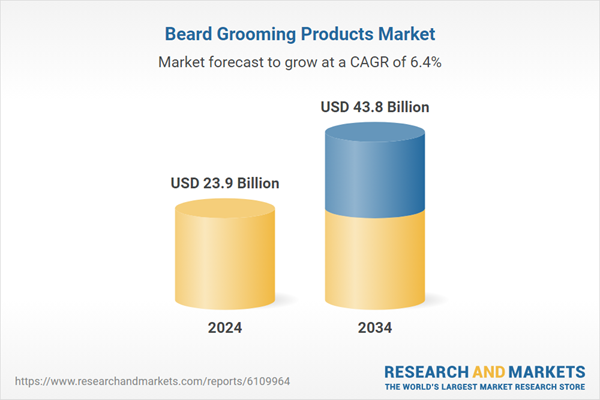Despite these growth drivers, the market faces challenges, including rising saturation. A growing number of brands are offering nearly identical product lines - beard oils, balms, creams, trimmers - making it harder for companies to carve out distinct brand identities. As competition intensifies, it becomes difficult for businesses to maintain profit margins, often resulting in pricing pressures. Additionally, regulatory complexities surrounding ingredient standards, marketing claims, and labeling requirements vary across international markets. These regulations present particular hurdles for smaller companies, limiting their ability to scale or enter global markets due to compliance costs and logistical difficulties.
In terms of product type, creams and balms dominated the market in 2024, generating USD 9.3 billion in revenue and are anticipated to grow at a CAGR of 6.3% during the forecast period. These products continue to gain popularity due to their multifunctional properties, offering conditioning, moisturizing, and light hold benefits in a single application. Their ease of use and effectiveness make them appealing to consumers seeking a streamlined grooming process. Beard balms, in particular, provide a practical styling solution with their thicker texture, allowing for better control without leaving a greasy residue. Their deeply moisturizing ingredients help improve beard texture over time, making them a preferred choice for consumers with medium to long beards.
By end use, the individual consumer segment emerged as the market leader in 2024, accounting for 57% of the total revenue, and is forecast to grow at a CAGR of 6.5% through 2034. One of the key factors boosting this segment is the rise of at-home grooming practices, encouraged by the widespread availability of instructional content online. More men are opting to manage their grooming independently, reducing reliance on professional barbers. This trend has led to a surge in demand for user-friendly products designed for personal use. Additionally, the popularity of online shopping and subscription-based services is further supporting segment growth. These platforms provide convenience, timely deliveries, and personalized grooming solutions, creating stronger customer engagement and loyalty. Affordability and wide availability of DIY grooming kits make them accessible to a broad consumer base, reinforcing their dominance in the market.
From a distribution standpoint, offline retail held the largest share in 2024, capturing 71% of the global market, and is projected to expand at a CAGR of 6.1% over the next decade. Physical retail remains essential for many consumers, particularly those who value the opportunity to sample products firsthand before purchasing. In-store consultations and recommendations contribute to product discovery, especially for new users seeking tailored advice. Convenience also plays a role, with grooming products frequently added to carts during regular shopping trips at supermarkets or pharmacies. Salons and barbershops contribute to offline sales through word-of-mouth promotion and point-of-sale offerings. Nonetheless, the digital channel is gaining momentum due to rising tech adoption and wider product assortments. E-commerce is becoming more dynamic with tailored shopping experiences, AI-powered recommendations, and interactive product demos that simulate in-store experiences.
In terms of regional performance, the United States led the market with a significant 80% share of the North American region and generated USD 5.7 billion in revenue in 2024. The mature grooming culture in the country, combined with strong consumer awareness, supports consistent demand. American men are showing a growing interest in maintaining well-groomed appearances, fueling purchases across various grooming categories. The local industry benefits from well-established companies that are aligning their offerings with consumer preferences, especially for clean-label products and innovative formulations. Strategic business moves such as mergers, facility expansions, and collaborative product development are strengthening market positions. Companies are actively investing in R&D to improve product functionality and aesthetics, while also emphasizing environmentally conscious packaging and ethical ingredient sourcing. These factors continue to define the evolving dynamics of the beard grooming products landscape.
Comprehensive Market Analysis and Forecast
- Industry trends, key growth drivers, challenges, future opportunities, and regulatory landscape
- Competitive landscape with Porter’s Five Forces and PESTEL analysis
- Market size, segmentation, and regional forecasts
- In-depth company profiles, business strategies, financial insights, and SWOT analysis
This product will be delivered within 2-4 business days.
Table of Contents
Companies Mentioned
- Beard Club
- CALYNDIA
- Conair
- Every Man Jack
- Golden Grooming
- Helios Lifestyle
- J&J Beard Company
- Manscaped
- McNROE Consumer Products
- Procter and Gamble
- Stubble + Stache
- Texas Beard Company
- Ustraa
- Wahl Clipper
- ZOUSZ
Table Information
| Report Attribute | Details |
|---|---|
| No. of Pages | 220 |
| Published | June 2025 |
| Forecast Period | 2024 - 2034 |
| Estimated Market Value ( USD | $ 23.9 Billion |
| Forecasted Market Value ( USD | $ 43.8 Billion |
| Compound Annual Growth Rate | 6.4% |
| Regions Covered | Global |
| No. of Companies Mentioned | 15 |









